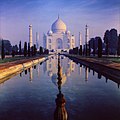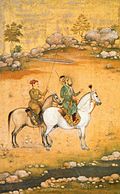Shah Jahan
Shahab-ud-din Muhammad Khurram[1] (5 January 1592 – 22 January 1666), better known by his regnal name Shah Jahan (Persian: شاه جهان Persian pronunciation: [ʃɑːh d͡ʒahɑːn]; lit. 'King of the World'), was Mughal emperor in India from 1628 until 1658. He was the fifth ruler of the Mughal dynasty.
The period of his reign is considered as the golden age of Mughal art and architecture. Shah Jahan is best known for erecting many splendid monuments, the most famous of which in all the world, is the Taj Mahal at Agra, built in 1632–1648 as a tomb for his beloved wife, Mumtaz Mahal.
Family
Akbarabadi Mahal, Kandahari Mahal, (most beloved wife) Mumtaz Mahal, Hasina Begum Sahiba, Muti Begum Sahiba, Qudsia Begum Sahiba, Fatehpuri Mahal Sahiba, Sarhindi Begum Sahiba and Shrimati Manbhavathi Baiji Lal Sahiba were the wives of Shah Jahan. Shah Jahan killed Mumtaz's husband to marry her. Mumtaz died during her 14th delivery. After her death, Shah Jahan married Mumtaz's sister.
Birth
Shah Jahan (also known as Prince Khurram) was born on 5 January 1592 at Lahore, Pakistan, and was the third son of Prince Salim (later known as 'Jahangir' upon his accession). His mother was a Rajput princess from Marwar called the Princess Jagat Gosaini (her official name in Mughal chronicles was Bilqis Makani). The name "Khurram" (joyous) was chosen for the young prince by his grandfather, Emperor Akbar, with whom the young prince was close in relation.
Just prior to Shah Jahan's birth, a soothsayer had reportedly predicted to the childless Empress Ruqaiya Sultan Begum, Akbar's first wife and chief consort, that the still unborn child was destined for imperial greatness. So, when Shah Jahan was born in 1592 and was only six days old, Akbar ordered that the prince be taken away from his mother and handed him over to Ruqaiya so that he could grow up under her care, and Akbar could fulfill his wife's wish to raise a Mughal emperor. Ruqaiya assumed the primary responsibility for Shah Jahan's upbringing and he grew up under her care. The two shared a close relationship with each other as Salim noted in his memoirs that Ruqaiya had loved his son [Shah Jahan ], "a thousand times more than if he had been her own [son]."
Shah Jahan remained with her [Ruqaiya] until he had turned almost 14. After Akbar's death in 1605, the young prince [Khurram] was allowed to return to his father's household, and thus, be closer to his biological mother.
Education
As a child, Shah Jahan received a broad education befitting his status as a Mughal prince, which included martial training and exposure to a wide variety of cultural arts, such as poetry and music, most of which was inculcated, according to court chroniclers, by Akbar and Ruqaiya. In 1605, as Akbar lay on his deathbed,Shah Jahan, who at this point was 13, remained by his bedside and refused to move even after his mother tried to retrieve him. Given the politically uncertain times immediately preceding Akbar's death, Shah Jahan was in a fair amount of physical danger of harm by political opponents of his father, and his conduct at this time can be understood as a precursor to the bravery that he would later be known for,he was also well known for his intelligent brain and creative ideas.
Governorships
Punjab 1608-1611
Deccan 1611–1612
Bihar 1613–1614
Gujarat 1614–1618
Delhi 1623–1627
Bengal 1624–1625
Bihar 1625–1627
Religious attitude
Shah Jahan leading the Mughal Army, in the upper left the war elephants bear emblems of the legendary Zulfikar sword. Shah Jahan was more radical in his thinking than his father and grandfather. Upon his accession, he adopted new policies which reversed Akbar's treatment of non-Muslims. In 1633, his sixth regnal year, Shah Jahan began to impose his interpretation of Sharia provisions against construction or repair of churches and temples and subsequently ordered the demolitions of newly built Hindu temples. He celebrated Islamic festivals with great pomp and grandeur and with an enthusiasm unfamiliar to his predecessors. Long-dormant royal interest in the Holy Cities was also revived during his reign. The Eid festival was celebrated with great splendour and great feasts especially in the capital city of Delhi.
Shah Jahan Media
The Taj Mahal, the burial place of Shah Jahan and his wife Mumtaz Mahal
The Submission of Rana Amar Singh of Mewar to Prince Khurram, Tuzk-e-Jahangiri.
Shah Jahan at his Durbar, from the Windsor Padshahnama, c. 1657
Throne of Mughal Emperor Shah Jahan of India, Red Fort, Delhi
Painting of Shah Jahan hunting Asiatic lions at Burhanpur, present-day Madhya Pradesh, from 1630
Shah Jahan and his eldest son Dara Shikoh.
References
- ↑ The Oxford handbook of Sikh studies. Oxford. 2016. ISBN 0-19-969930-5. OCLC 874522334.







